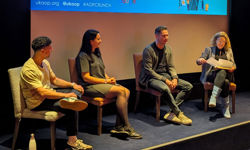Now more than ever, it is important to reach out to consumers. With such a wide selection of magazines on offer and less cash in pockets, many publishers are looking for growth by reaching out beyond print, bringing their brands to other relevant platforms, which offer new revenue potential.
Many publishers are broadening their offering far beyond print to span a wide range of editorial options: from radio and television to podcasts, blogs, online video and mobile content. For the right brands, it is less about being constricted by platforms and more about becoming branded content providers. Especially as media consumption patterns are changing so rapidly with the array of new technologies available. And that’s not all: traditional advertising spend has also widened to the event platform, and a number of magazine brands - from Country Living to Amateur Gardening - have crafted their own live events, bringing advertisers along for the ride.
For many, the first step would be to take your brand online, and many magazines these days have a website if they have an online audience to serve. The most successful brands take the website and use multimedia platforms to interact with the visitor rather than to just try to replicate the magazine experience or sample sections of the magazine. It could be said that web advertisers led the way using rich media technology to reach and engage with visitors. Advertisements may have features such as peeling back, floating over the page, expanding or appearing between pages in order to engage potential customers. Advertisers as well as consumers continue to ask for new and exciting ways to interact with the magazine brand.
Podcasts
One way to approach this is with podcasts and videos. It's all about creating great content and then getting people talking about it - and consequently talking about you and your brand. You can do that with words on a page (you may have come across the ‘blog’!), but when it comes to even greater ‘pass it on' value, there's nothing like sound and pictures. This doesn’t need enormous amounts of investment and the major advantage is that you can publish video and podcasts on your own site. With the pace of modern technology, podcasts are already old news, however they should not be overlooked as they are measurable and relatively inexpensive. You can create highly relevant, niche content and then promote it to a specific target market. BBC History magazine has put the podcast to good use to bring their longer features and well known writers to life and Web User uses its podcast to tap into its readers’ keen interest in editorial insight and reviews.
Videos
Online video has also become very popular, as video sites such as YouTube.com have become an online phenomenon, and UK consumers are increasingly supplementing their TV consumption with online material (Nielson Online Data 2007). This is also reflected in US figures, where, according to a report from September 2007 (Bivings Group), the proportion of leading US magazines (the top 50 by circulation) that offer online video nearly doubled from 34% in 2006 to 60% in 2007. Many websites have successfully utilised video content either for product reviews, or going further to create entire "TV" channels to group together video content, such as on gadgets site www.stuff.tv. Production values do not have to be expensive and a standard handheld video camera is often all that is needed for simple reviews or interviews.
Golf Monthly started Video Vault, featuring golf equipment reviews, in the summer of 2007 and saw a 15% increase in traffic to the site within the first month. Publisher Adrian Booker is enthusiastic about the results. "Video has given us the opportunity to feature new equipment launches in a unique way, allowing users to see our testers with the products and then instantly giving their opinions and thoughts. While magazine based reviews have more depth and insight, video has given us the opportunity to feature the latest products as soon as manufacturers’ embargoes are lifted - this is a real breakthrough for golfers everywhere."
Based on the success of the Video Vault, Golf Monthly rolled out golf instruction channel on to the site in 2008 and while this is by its very nature more generic and less time sensitive, early user feedback and traffic has been very positive. YouTube channel video views have been over 250,000 since launch.
Radio and TV
There are several magazines which have the audience to bring their brand to radio and TV. One such multi-faceted brand is NME which, with its music focus, launched its own digital TV channel in late 2007 and has followed this up with a (now award-winning) digital radio channel in June 2008. NME Radio broadcasts from studios in the same building as the print operation, and the different platforms share a common NME ‘playlist’. Other music brands have taken a similar route, for example Q Radio, Mojo Radio and Kerrang Radio. From outside the music sector, Bauer’s Heat Radio, also launched in September 2007, works as a converged magazine and radio operation with a studio embedded in the magazine office. And to judge by Q Radio’s 333,000 weekly audience figures, this is definitely an audience worth chasing.
In a recent interview, publishing director Paul Cheal summed up how the channels would help expand the NME brand. "Ideally, an NME reader can flick through the magazine during the day, visit the site in the afternoon, come home and watch NME TV, before going to an NME club to see an NME gig."
Events
Music and youth brands do lend themselves well to the radio and TV platforms not only because of their type of content but also because of the demographic of the target audience. However, each magazine can play to its strengths in order to expand the brand reach. Food and home magazines have been successfully running or collaborating on live events such as the BBC Good Food show and Country Living's Christmas Fair for several years. As a smaller niche brand, Decanter magazine has successfully created a variety of live wine tasting events and dinners to reach core and new readers. Each event is crafted to represent the key areas of the print brand, bringing together in-depth knowledge of wine, the contacts to bring winemakers to events from around the world, and links with key writers and educators, all coming together within premium surroundings in the heart of London.
Attending events to bring your magazine brand values to new consumers can also work well particularly for specialist magazines even if the event is not own-branded. This can involve the large expense of bespoke stands and staffing but the opportunity it gives to bring brands to life and connect with a large and targeted audience should balance out the cost.
There are other multimedia platforms such as mobile and digital magazines which as yet appeal most to early adopters of technology. Many publishers are experimenting with formats to make sure they are there when the technology and ideas finally come together for a great user experience. There are exceptions that have utilised mobile content very well with current technology, such as men’s magazines like Zoo and Nuts where the content is mainly picture led. And the digital magazine format has also been used by magazine brands to provide free samples at low cost as well as producing exact paid-for versions of the magazine for a small but growing audience who prefer this method of delivery. However, so far, these methods of editorial delivery have not gained momentum.
While some platforms have not quite found their place, magazine publishers have been stretching out even further to broaden their reach of consumers in the digital space. A recent example is IPC Ignite, which last year acquired online casual games site www.mousebreaker.com to add to its existing portfolio, including Loaded and Uncut. The acquisition doubled Ignite’s reach of hard-to-reach young men online. And in 2006 the National Magazine Company invested in the acquisition of Handbag.com and Netdoctor.co.uk – bringing great digital talent into the business and creating scale at speed rather than organically.
It would seem that, with the support of consumers and advertisers, the opportunities to enhance the experience of the magazine brand will continue to grow and develop in new and exciting directions. In the end, increased interaction with readers could be more important than increasing printed circulation. Interaction builds confidence, trust, and revenue. The key is to never forget your audience and make sure you work with them every step of the way.
FEATURE
Bringing your brand to life
To survive and thrive, publishers really do need to be media neutral and to engage with their readers in a wide variety of settings. To communicate through one channel alone – be it on or offline – is one dimensional and extremely limiting. Sophia Dempsey looks at how some magazine brands are utilising a range of media to reach their audiences.










